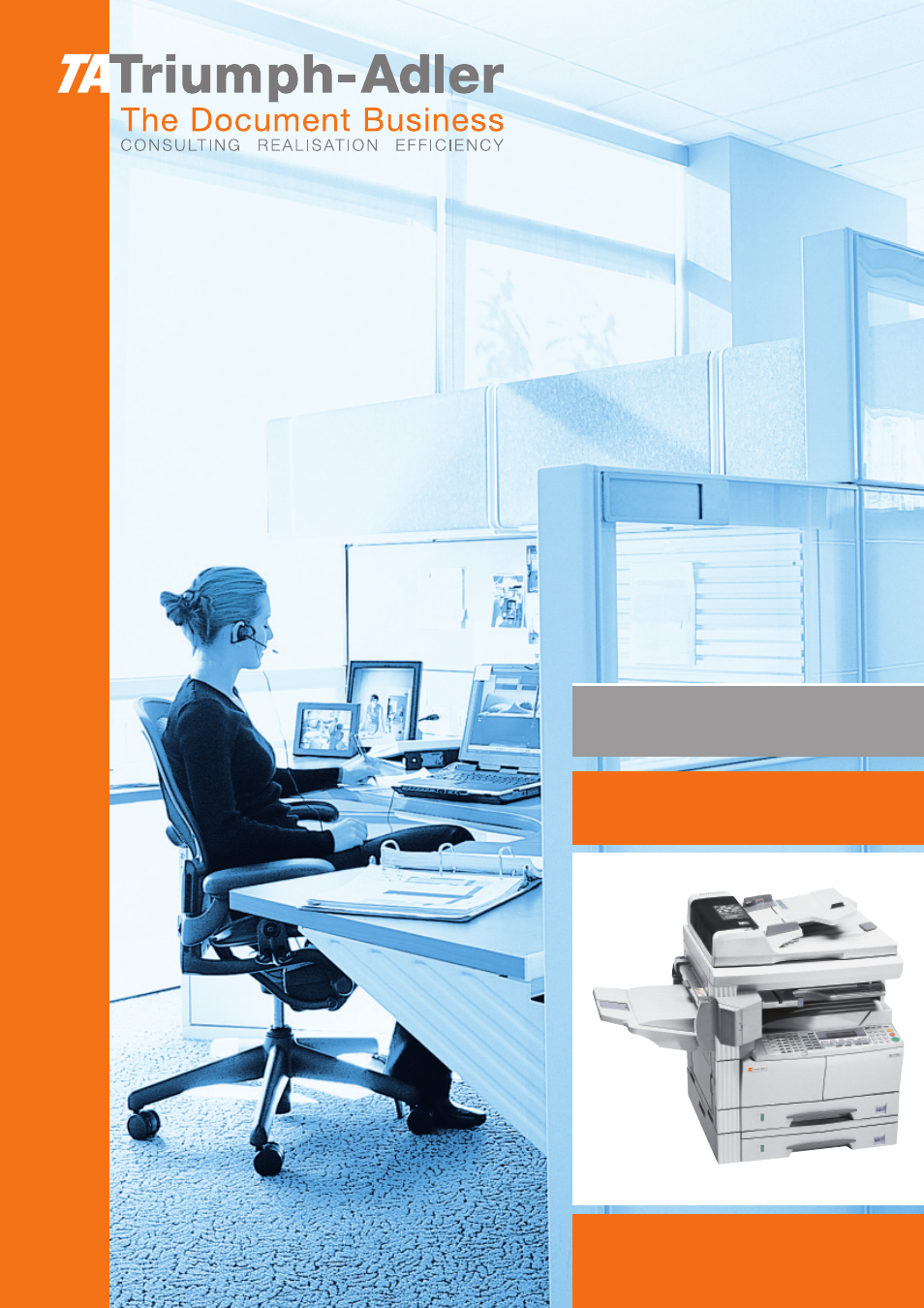TA Triumph-Adler DC 2116 User Manual
TA Triumph-Adler Copiers
Table of contents
Document Outline
- Introduction
- CONTENTS
- IMPORTANT! PLEASE READ FIRST.
- 1 Fax Operation (Names of Parts / Preparations / Features and Functions of this Fax)
- Names of Parts
- Preparations
- Features and Functions of this Fax
- Switching from the Copy Operation Mode to the Fax Operation Mode
- What is the “Initial Mode”?
- What is the Administrator Password Used For?
- When You Press the Reset Key...
- Automatically Clearing the Current Settings (Auto Clear function)
- Using a 3-digit Document Number to Manage Fax Communications (Document Number)
- Automatically Engaging the Energy Saving Mode (Auto sleep function)
- Sending a Fax Directly from a Network Computer (Network FAX functions [option])
- Handling 2 Jobs Simultaneously (Dual Access function)
- Sending Multiple Sets of Documents in One Batch (Batch Transmission function)
- Rotating the Document Image for Transmission (Rotate & Transmit function)
- Verifying IDs With the Other Party Using Subaddresses (Subaddress Communication)
- Receiving Documents Even When Paper Has Run Out (Memory Reception function)
- Backing Up Memory Even During a Power Failure (Image Memory Backup function)
- Rotating Received Data to Fit the Available Paper (Rotate Received Data function)
- 2 Fax Operation (Basic Use)
- Sending Documents
- Receiving Documents Automatically (Automatic Fax Reception)
- Canceling a Communication
- Printing Out Received Documents Even During Copying (Fax Priority Printout function)
- Make Copies Even During Printing of an Incoming Fax (Copy Priority Printout function)
- Entering Characters
- Dialing the Destination Using Only One Key (One-Touch Keys)
- Using a 3-Digit Number to Select the Destination (Abbreviated Numbers)
- Dialing the Destination Using the Address Book (Address Book)
- Dialing the Same Number Again (Redailing functions)
- 3 Various Functions of this Fax
- Sending 2-Sided Documents (Duplex Transmission)
- Preparing the Next Documents During Another Communication (Standby Transmission)
- Sending the Same Documents to Multiple Destinations (Broadcast Transmission)
- Sending Important Documents Before Others (Interrupt Transmission)
- Sending Documents at a Specified Time (Communication Using the Timer)
- Dialing the Destination With A Registered Number and the Keypad (Chain Dial Keys)
- Managing Information for a Scheduled Communication (Editing a Communication in Memory)
- Initiating the Fax Connection Manually (Manual Fax Transmission)
- Initiating the Fax Connection Manually (Manual Fax Reception)
- 4 Troubleshooting
- 5 Other Features of this Fax
- Automatically Switching Between the Fax and a Telephone (Auto FAX/TEL Switching)
- Automatically Switching Between the Fax and an Answering Machine (TAD Reception)
- Using Different Fax and Telephone Numbers (D.R.D. Reception) [Available in inch versions only]
- Initiating Fax Reception From a Connected Telephone (Remote Switching)
- Allowing the Receiving Party to Initiate Communication (Polling Communication)
- Communicating Using Subaddresses (Subaddress Communication)
- Communicating Confidentially (Subaddress-based Confidential Communication)
- Registering New Subaddress Confidential Boxes
- Modifying or Deleting Subaddress Confidential Boxes
- Sending Documents Using Subaddress-based Confidential Transmission
- Printing Out Documents from a Subaddress Confidential Box
- Printing Out a Subaddress Confidential Box List
- Entering Documents into a Subaddress Confidential Box
- Receiving Documents from a Subaddress-based Bulletin Board
- Using a Relay Station to Send Your Documents (Subaddress-based Relay Broadcast Communication)
- Having Received Faxes Forwarded to Another Fax Number (Fax Forwarding)
- Dialing Multiple Destinations as a Group (Group Dial Keys)
- Saving Specific Communication Settings as a Single Program (Program Keys)
- Enabling Communication Only When Certain Passwords Match (Password Check Communication)
- Communicating with Encrypted Documents (Encrypted Communication)
- Registering New Encryption Keys
- Modifying or Deleting Encryption Keys
- Registering New Encryption Boxes
- Modifying or Deleting Encryption Boxes
- Performing the Operation at the Transmitting Fax
- Performing the Operation at the Receiving Fax
- Printing Out Documents from an Encryption Box
- Printing Out an Encryption Key List
- Printing Out an Encryption Box List
- Managing Fax Use by Each Department (Restricted Access)
- 6 Managing Information About Your Fax Communications
- 7 Various Settings and Registration
- Turning Print Out of Each Report ON/OFF ("Print Report" setting)
- Turning the Bulletin Board ON/OFF ("Bulletin Board" setting)
- Setting the Number of Rings [Auto Fax Reception] ("Number of Rings" setting)
- Setting the Number of Rings [TAD Reception] ("Number of Rings" setting)
- Setting the Number of Rings [FAX/TEL Switching] ("Number of Rings" setting)
- Confirming the Destination Information Before Dialing ("Dial Confirm” setting)
- Making Volume Settings ("Volume" setting)
- Setting the Document Size for Scanning from the Document Processor ("Scan from DP" setting)
- Setting the Default Transmission Mode ("TX Mode/Default" setting)
- Selecting the Automatic Reception Mode ("Receive Mode" setting)
- Turning Reception Date & Time Print Out ON/OFF ("RX Date/Time" setting)
- Selecting the Paper Feed Selection Mode ("Fax Paper Feeding Tray" setting)
- Turning 2 in 1 Reception ON/OFF ("2 in 1 RX" setting)
- Turning Remote Diagnosis ON/OFF ("Remote Diagnosis" setting)
- Registering the Remote Test ID ("Remote Test ID" setting)
- Receiving Faxes at the Same Size or a Reduced Size (“Reception size” setting)
- Turning Bulk Fax Reception ON/OFF ("Fax bulk reception” setting)
- 8 Optional Equipment
- 9 Network FAX Settings (Option)
- 10 Reference Information

